Innovative Dog-Proof Yard Ideas for Pet Owners
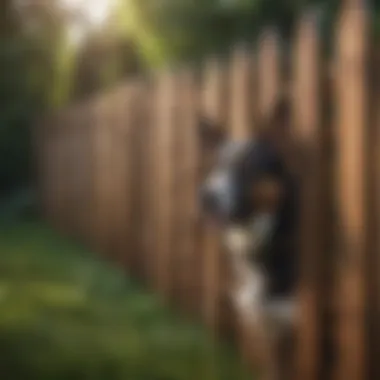
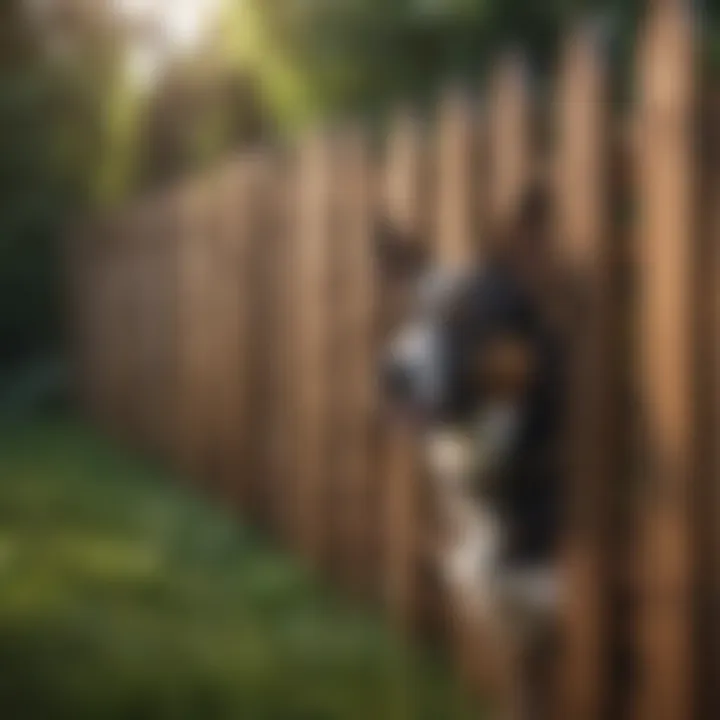
Intro
Creating a dog-proof yard is not just about keeping your pet safe; it encompasses an aesthetic appeal and functional design. Many homeowners seek to strike a balance where their outdoor space caters to their dogs while remaining visually inviting. This need becomes even more pressing as more families embrace pets as integral members of the household.
Pet owners often encounter challenges such as digging, chewing, and unwanted escapes. Thus, a thoughtful approach is critical when designing a safe and appealing environment. This guide aims to provide practical solutions and innovative ideas that can help you navigate the process of crafting a dog-friendly yard.
By exploring topics such as fencing options, landscaping strategies, and the inclusion of safe areas for play, this article empowers dog owners. You will find detailed insights that support effective planning and execution.
Let’s delve into design inspiration to form the backbone of your pet-friendly paradise.
Understanding the Need for a Dog-Proof Yard
Creating a dog-proof yard is essential for ensuring your pet's safety and enhancing their quality of life. A well-thought-out yard design can mitigate potential dangers while providing an inviting space for your dog to play. This section outlines the importance of having a secure outdoor environment that considers both the owner's aesthetic preferences and the canine's needs.
The Importance of Safety
Safety is the primary concern for any dog owner. Unfortunately, many yards have hidden hazards that can lead to accidents or injuries. These may include sharp objects, toxic plants, or uneven surfaces. When designing a dog-proof yard, the focus should be on eliminating these risks. Ensuring a safe environment helps prevent injuries and also reduces anxiety for the owner.
Owners can take proactive measures to protect their pets. Regular checks for potentially hazardous substances or experiences, such as lawn chemicals or thorny plants, are important. Any planning should involve considering the dog's activities. Dogs are naturally curious and active; their exploration may lead them to unexpected dangers. Thus, a dog-proof yard should reflect the balance between functionality and safety.
Common Risks for Dogs in Yards
Several risks can arise in even the most well-maintained yards. Among these, some are more prevalent and require attention.
- Toxic Plants: Certain flowers and shrubs, like azaleas and sago palms, can be poisonous if ingested. It's crucial to research which plants are safe for dogs and remove or replace those that pose a risk.
- Sharp Objects: Items like broken glass, metal scraps, or any sharp tools stored in the yard can be harmful. Keeping the area tidy and free of debris is essential.
- Unstable Structures: Features like loose fences, unstable decks, or any malfunctioning elements can present dangers. Regular inspection and maintenance are vital to ensure stable structures.
- Pesticides and Chemicals: Lawn care products often contain chemicals that are harmful to pets. Opt for pet-safe alternatives when caring for your yard.
- Intrusions by Other Animals: Unfenced or poorly secured yards can invite stray or wild animals, which can pose threats to your dog. This underlines the importance of robust fencing solutions.
In summary, a proactive and informed approach to yard safety ensures not only the wellbeing of pets but also peace of mind for their owners. Understanding these risks allows for more effective prevention strategies.
Assessing Your Yard's Potential and Limitations
Assessing your yard's potential and limitations is a crucial step in creating a dog-proof environment. This process involves understanding your yard's unique features and what challenges may arise when integrating your dog's needs into the design. The analysis allows you to maximize the available space while minimizing risks that could harm your pet. By identifying both opportunities for enhancement and existing hazards, you can make informed decisions that enhance functionality and aesthetics.
Site Analysis: Evaluating Space
When evaluating your yard, begin with a thorough site analysis. You need to observe the layout, dimensions, and any natural features that could benefit or hinder your dog's mobility and safety. Take note of areas with sufficient space for play, relaxation, and training. Consider the sunlight, shade, and wind patterns as well, as these elements significantly influence your dog's comfort.
It can be useful to measure the total area of your yard. Understanding the measurements will help determine if you need to make adjustments like resizing play zones or creating designated areas.
- Consider the following aspects during the site analysis:
- Current landscaping and natural elements like trees and bushes.
- Accessibility for maintenance and potential installation of features such as fencing.
- Proximity to roadways or areas with potential hazards.
- Any existing structures like decks or patios that could be integrated or need modifications.
Identifying these factors allows for better spatial planning and more effective integration of your dog's needs into the design.
Identifying Hazardous Areas
Alongside the exploration of potential, it's essential to identify hazardous areas in your yard. These are spots that could pose risks to your dog’s health and safety. Common hazards may include:
- Toxic plants: Some plants are harmful to dogs if ingested. Research which ones in your yard are unsafe. Examples include oleander and sago palm.
- Unsecured items: Tools and equipment left out can lead to injuries if your dog plays around them.
- Water features: While a dog may enjoy water, deep pools or ponds can be dangerous without supervision.
A detailed inspection allows you to address these issues proactively. It could involve removing toxic plants or installing barriers around hazardous water features. Documenting these areas helps you maintain a safer environment for your dog.
"Proactive assessment can save lives. A dog-friendly yard requires both planning and adjustment to ensure safety."
In summary, assessing your yard's potential and limitations helps create a balanced pet-friendly environment. Thorough site analysis paired with identifying hazardous areas enhances the safety of your dog while allowing for creative designs that incorporate both function and pleasure.
Fencing Solutions: Securing Your Dog's Domain
Fencing is an essential component in creating a dog-proof yard. A well-constructed fence provides safety for dogs while allowing them to explore their space freely. When designing a yard with dogs in mind, the right fencing solution not only keeps pets contained but also protects them from potential threats, such as stray animals or vehicles. Furthermore, effective fencing can enhance the aesthetic appeal of your yard, contributing to the overall design.
Types of Fencing Materials
Wood Fencing
Wood fencing is a classic choice for dog owners, known for its natural appearance and solid structure. It contributes significantly to creating a private space for your pet. One of the key characteristics of wood fencing is its versatility in design. It can be made to various heights and styles, allowing it to blend seamlessly with the surrounding environment. Wood fencing is beneficial because it provides excellent security while limiting dogs' visibility to external distractions, which can help reduce barking.
However, wood requires regular maintenance to prevent rot and decay. It can be susceptible to chewing by active dogs, which may lead to costly repairs over time. Still, the aesthetic appeal and ability to customize make wood fencing a popular option for many dog owners.
Vinyl Fencing
Vinyl fencing presents another appealing option for creating a dog-proof yard. Its high durability and low maintenance needs are standout features. Vinyl fences can withstand harsh weather and do not require painting or staining like wood does. This feature makes vinyl a practical choice for dog owners who seek a long-lasting solution without the hassle of regular upkeep.
The smooth surfaces of vinyl fences also prevent dogs from getting a grip to climb or jump over. However, it may not always provide the same level of privacy as wood, depending on the design. Additionally, while vinyl is usually more expensive initially, its longevity can justify the costs in the long run.
Chain Link Fencing
Chain link fencing is a more economical choice for securing your dog’s domain. Its transparent structure allows for visibility while providing a secure enclosure. The key characteristic of chain link fencing is its strength and resilience against force. This can be especially beneficial in neighborhoods with active pets or potential intruders.
One unique feature of chain link is the ability to add slats or privacy inserts, enhancing visual barriers without compromising safety. Despite its benefits, chain link may not deter small breeds since they can often squeeze through the links, so it is more suitable for larger dog breeds. Overall, chain link fencing offers a practical and cost-effective solution for dog owners.
Height and Design Considerations
Choosing the right height for the fence can greatly impact your yard's safety. For most medium to large breeds, a fence height of at least six feet is advisable to prevent jumping or climbing. Smaller dogs may require different considerations, such as ensuring there are no gaps at the bottom that can be squeezed through.
In terms of design, consider whether a solid wall or a more open structure best fits your yard and dog. Solid barriers can help reduce distractions, while chain link or vinyl might allow for better airflow and visibility, making playtime more enjoyable. Every aspect of fence design should take the specific behavior and physical abilities of your dog into account.
Creating Specialized Play Areas
Creating specialized play areas for dogs is a vital component when designing a dog-proof yard. These areas not only provide a space for exercise and fun but also contribute positively to a dog's mental and emotional well-being. By tailoring zones specifically for your pet's needs, you can ensure that your yard becomes a stimulating environment that encourages active play while minimizing potential risks.
Designing Dog-Friendly Zones
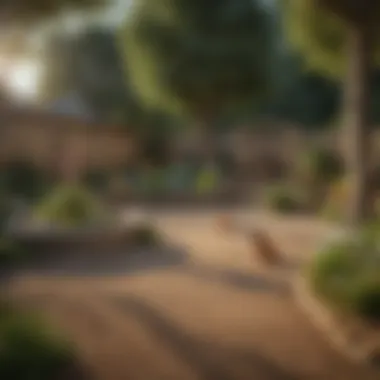

When planning dog-friendly zones, the first step is to consider the dog's size, breed, and energy levels. Different breeds have varying requirements for space and stimulation. For example, an active breed like a Border Collie may require a larger area to run and play compared to a smaller breed like a French Bulldog. Designing spaces accordingly will make a significant difference in how much your dog enjoys and utilizes the area.
In addition to sufficient space, it is crucial to select the right surface materials. Grass is a common choice, but it can be challenging to maintain. Artificial turf is another option, providing a consistent surface that doesn't muddy easily and reduces maintenance needs. Furthermore, incorporating soft play surfaces can help prevent injuries.
Key Elements of Dog-Friendly Zones:
- Physical Space: Ensure there is enough space for running, jumping, and playing.
- Surface Material: Choose easy-to-maintain and durable materials such as artificial turf or rubber mats.
- Enrichment Features: Incorporate items such as play tunnels, agility equipment, or even a sand pit for digging, which can keep dogs engaged.
Incorporating Training Areas
Incorporating training areas within your dog's play zones offers an excellent opportunity for structured activities. Training can happen through positive reinforcement, which is essential in shaping desirable behaviors. By establishing clear training zones, owners can efficiently work with their dogs in a setting free from distractions.
The training area can be enclosed or semi-enclosed to focus the dog's attention. Utilizing cones, hurdles, or agility equipment helps to develop a dog's agility and obedience skills. These elements not only serve as training tools but also as stimulating toys that can enhance playtime.
Considerations for Training Areas:
- Equipment: Include agility jumps, weave poles, or tunnels designed for dog training.
- Boundary Setting: Ensure there is a clear boundary to help focus training efforts and avoid distractions.
- Visibility: The area should be visible from the house, allowing for easy supervision while training.
In summary, the creation of specialized play areas is essential in making a yard safe and engaging for dogs. By thoughtfully designing dog-friendly zones and incorporating training areas, pet owners can transform their yards into unique environments that cater to their pets' needs and enhance overall quality of life.
"A well-designed play zone can bridge the gap between fun and functionality in a pet-friendly yard, creating an ideal space for dogs to thrive."
Focusing on these details helps establish an inviting atmosphere for both pets and their owners.
Choosing Safe and Durable Landscaping Materials
Creating a dog-proof yard requires careful selection of landscaping materials. Ensuring that these materials are both safe for pets and durable against wear and tear is crucial. Not only does this contribute to the safety and well-being of the pets, but it also means a lower likelihood of replacement or repair costs in the long run. This section discusses the significance of selecting appropriate landscaping elements, with a focus on non-toxic plants and sustainable mulching options.
Plants and Flowers Safe for Dogs
When choosing plants and flowers, it is essential to prioritize safety for dogs. Certain plants may pose a risk if ingested, leading to various health issues. Here are some dog-friendly options to consider:
- Snapdragons
- Marigolds
- Zinnias
- Icelandic Poppies
- Bamboo
In addition to being safe, these plants also add visual appeal to the yard. Homeowners should verify that any chosen plants do not contain harmful substances that could adversely affect their pets. This consideration ensures that a beautiful landscape does not come at the expense of a dog's health.
Non-Toxic Mulching Options
Mulching is another important aspect of landscaping. Using non-toxic options for mulch is necessary for creating a secure environment. Some materials that are safe for dogs include:
- Cedar Mulch
- Pine Chips
- Coconut Coir
- Rice Hulls
These alternatives not only protect the soil and help retain moisture but are less likely to be harmful if ingested. Additionally, opting for organic mulch rather than chemically treated ones can keep the yard free of harmful pesticides and herbicides.
A safe yard is not just about aesthetics, it is about creating a healthy space for your pets to live and play.
Choosing suitable plants and mulching materials contributes to a stress-free outdoor space for both pets and owners. By conducting thorough research and opting for dog-safe options, one can ensure a beautiful and secure yard.
Implementing Environmental Enhancements
Creating an engaging environment for dogs goes beyond mere safety; it also enhances their overall well-being. Implementing environmental enhancements in your dog-proof yard is essential for providing physical activity, mental stimulation, and comfort. Elements like water features and shaded areas encourage dogs to explore their surroundings. This section outlines two significant features: dog pools and water features, and shaded areas for comfort, explaining their benefits and how to integrate them into your design.
Dog Pools and Water Features
Water features can transform your yard into a recreational space for both dogs and their owners. A dog pool offers a dedicated area for your pet to cool off, promoting hydration and exercise. Dogs enjoy swimming and playing in water, which reduces their stress and provides an outlet for excess energy.
When designing this feature, consider these factors:
- Size and Depth: The pool should be suitable for your dog's size. Small breeds may only need a shallow area, while larger breeds require deeper sections.
- Material: Choose durable, non-toxic materials. Concrete or vinyl can withstand scratching and are easy to clean.
- Accessibility: Incorporate steps or ramps for easy entry and exit, especially for older dogs or those with mobility issues.
Beyond pools, water features such as fountains or streams can attract dogs while enhancing the visual appeal of your yard. The sound and movement of water can also be stimulating, encouraging your dog to engage with their environment.
Shaded Areas for Comfort
Shade is crucial for protecting dogs from heat exposure. Dogs do not sweat like humans; they rely on panting and finding cooler spots. Implementing shaded areas in your yard can provide relief during hot weather and make the outdoors more enjoyable.
Consider the following when designing shaded areas:
- Natural Shade: Utilize existing trees for natural shade. Ensure that branches are safe and monitored, as falling limbs can pose hazards.
- Structures: Canopies, pergolas, or large umbrellas offer flexible solutions. These structures can be stylish while serving a functional purpose, allowing you to create a cozy retreat for your dog.
- Location: Place the shaded areas strategically in spots where your dog likes to rest or play. Observe your dog's behavior to identify their preferred sunbathing spots and provide alternatives.
Integrating these features not only caters to your dog's physical needs but also enhances the aesthetic appeal of your yard.
In summary, implementing water features and shaded areas can significantly enrich your dog's outdoor experience. Investing time and resources into these enhancements contributes to their physical and mental health, ensuring a happier, more balanced pet.
Integrating Functional Structures
Integrating functional structures into the yard design not only enhances the aesthetic appeal but also offers numerous benefits for pet owners. These structures serve practical purposes while creating a safe and engaging environment for dogs. By thoughtfully including elements such as dog houses, shelters, and raised platforms, homeowners can optimize both function and style in their outdoor spaces.
Dog Houses and Shelters
Providing adequate shelter is essential for any dog. Dog houses give pets a safe place to escape sun, rain, or wind. It is critical to choose the right design and materials. The house needs to be spacious enough for the dog to stand, turn around, and lie comfortably. Common materials for dog houses include wood, plastic, and metal; each has its pros and cons. For instance, wooden houses offer good insulation, while plastic can be easier to clean.
Design plays a vital role as well. A dog house should blend with the landscape and reflect the overall look of the yard. It may even contain elements such as ventilation systems or raised foundations to keep dogs cool and dry. Additionally, placing the shelter in a shaded area allows dogs to enjoy the outdoors without the risk of overheating.
"Creating a comfortable shelter goes a long way in ensuring the health and happiness of your pet."
Raised Platforms for Play
Raised platforms are innovative features that can stimulate a dog’s curiosity and exercise needs. These structures can be designed as part of an obstacle course or a simple play area. They allow dogs to climb, jump, and engage in vigorous activities. This kind of play is essential for their mental and physical well-being.
When designing raised platforms, consider the height and stability. The material must be sturdy enough to support jumping and climbing. Wood and composite materials are often suitable choices. Not only do they need to be durable, but it should also be non-toxic and safe for pets.
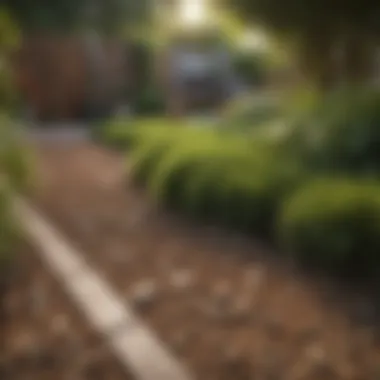

In addition to their functional aspect, raised platforms can also add visual interest to the yard. They can be decorated with plants or painted in colors that match the overall landscape, enhancing the outdoor aesthetic.
Exploring Sensory Engagement for Dogs
Creating a dog-friendly yard does not just involve physical safety measures. Dogs are sentient beings that thrive on sensory stimulation. Engaging their senses can enhance their emotional well-being and allow for a more interactive play environment. Incorporating sensory elements in your yard can lead to a happier dog and a more fulfilling experience for both pet and owner. From textural playscapes to aromatic pathways, understanding and integrating these components is crucial for a well-rounded dog-proof yard design.
Incorporating Textures and Scents
One of the simplest yet most effective ways to engage dogs is through the use of varied textures and scents. Different materials can be used in landscaping to create a stimulating area for exploration. For instance, consider mixing gravel, grass, mulch, and turf. Each offers a distinct feel under paw, encouraging dogs to investigate and move around.
Scents also play a significant role in sensory engagement. Dogs have a remarkable sense of smell and often explore the world through their noses. Planting scented flowers or herbs like lavender, rosemary, or mint can turn your yard into a sensory wonderland. Some dogs enjoy digging and sniffing around these plants, which help them to express natural behaviors. The incorporation of these sensory elements can significantly enhance your dog’s connection to the outside space.
Creating Digging Areas
Digging is a natural instinct for many dogs, and providing designated digging areas can satisfy this urge without destroying your yard or garden. Building a specific zone filled with sand or loose soil can cater to this behavior. Consider lining the area with a border to prevent it from spreading to unwanted places. In this area, you can even hide toys or treats to further entice your dog to dig and engage with their environment in a positive manner.
Maintenance Considerations for a Dog-Proof Yard
Creating a safe environment for dogs in your yard is an ongoing process that requires regular maintenance. Proper upkeep prevents potential hazards and ensures that the yard remains inviting and secure for your pets. Maintenance considerations are critical not just for the safety of animals, but also for preserving the overall beauty and functionality of the outdoor living space. Regular inspections, seasonal care, and adjustments contribute to a longer-lasting and healthier yard.
Regular Yard Inspections
Routine checks of your yard are essential for identifying any emerging threats or deteriorating areas. Inspecting the yard allows you to spot issues such as:
- Weak fencing: It is vital to ensure that all fencing remains intact to prevent escape.
- Hazardous plants: Some plants may become toxic over time or new ones might sprout.
- Debris accumulation: Fallen branches or trash can pose choking hazards.
A proactive approach helps manage these risks before they escalate. Establish a schedule for inspections, perhaps monthly, or more frequently during high-use periods when your dog is likely to be outside a lot. Note anything unusual and address issues promptly. Taking these steps keeps your space safe and enjoyable.
Seasonal Adjustments and Care
As seasons change, so do the requirements for yard maintenance. Understanding how winter, spring, summer, and autumn affect your space can help you mitigate risks and enhance comfort. Consider these:
- Spring: A good time to check for invasive weeds, which may be harmful to your pets. This is also when landscaping needs attention, including replacing or securing any damaged plants or mulch.
- Summer: Keep an eye out for hydration needs. Water features should remain clean. Ensure shaded areas are adequately covered with suitable plants.
- Autumn: Clear fallen leaves promptly. Decomposing leaves can attract insects and mold. Inspect fencing for wind damage that might happen during storms.
- Winter: Protect plants as much as possible from harsh weather. Ensure that materials used for snow and ice do not contain harmful chemicals.
"Keeping the dog-proof yard maintained enhances the pet's quality of life, making it a secure place to explore."
By adapting care routines to align with seasonal changes, you create a safe haven for pets year-round.
In summary, maintenance considerations for a dog-proof yard are not merely an afterthought; they are integral to ensuring a safe and enjoyable space for your pets. Regular inspections and seasonal adjustments can significantly improve the environment for your dogs, allowing them to thrive and play safely in your thoughtfully designed outdoor space.
Training Your Dog to Adapt to the Yard
Creating a secure environment for dogs goes beyond just physical barriers. Training plays a crucial role in ensuring that pets can navigate their yards safely and comfortably. Understanding how to train a dog to adapt to the space is essential for both safety and enjoyment. The benefits of this training are manifold, allowing dogs to feel more at ease while also minimizing risks associated with yard exploration.
Establishing Boundaries
Establishing clear boundaries is a critical step in training. This can involve physically marking off sections of the yard to help the dog understand where they are allowed to roam. It is important to start small. You can use flags, markers, or even simple visual cues to help your dog learn these limits. In time, the dog learns the areas that are designated for play and those that are off-limits.
Start by walking the dog around the yard on a leash. If they wander beyond set points, gently guide them back. Positive interactions during this process reinforce their understanding.
Key points to consider include:
- Consistency: Make sure everyone in the household applies the same boundaries.
- Age Considerations: Puppies might need more frequent reminders compared to older dogs.
- Supervision: Initially, supervise them during outdoor time to offer guidance.
- Signs: Consider placing signs or barriers to indicate no-go zones.
Positive Reinforcement Techniques
Using positive reinforcement is an effective method to train dogs. This involves rewarding good behavior with treats or praise when they respect the boundaries set. Positive reinforcement builds trust and promotes learning without fear or negativity.
When your dog stays within the observed boundaries, immediately reward them. Timely rewards encourage the repeat of those behaviors.
Some techniques to implement include:
- Praise: Verbal praise can serve as an effective reward.
- Treats: High-value treats reinforce the learning process.
- Playtime: Offering extra playtime can motivate your dog to follow commands.
To synthesize, training dogs to adapt to the yard is a necessary aspect that contributes to their safety and enjoyment. By establishing boundaries and employing positive reinforcement techniques, pet owners create an environment where dogs thrive.
"A well-trained dog is a safe and happy dog. Training transforms environments into trustworthy spaces for exploration and play."
This focus not only enhances owner satisfaction but is vital for the overall pet experience.
Evaluating Behavioral Needs Affected by Yard Design
In designing a dog-proof yard, it is critical to evaluate how the environment influences canine behavior. Dogs, as social creatures, express their needs and emotions through behavior. Understanding these aspects allows pet owners to create an environment that promotes not just safety but also mental and emotional well-being. Evaluating behavioral needs involves considering factors such as space utilization, interactive elements, and safety concerns.
Understanding Dog Behavior
Dogs communicate through actions. Their behavior reflects their comfort, stress levels, and excitement. By observing them, you can learn what they enjoy and what might make them anxious. For instance, dogs often require space to roam but also designated areas to feel secure. Without a clear understanding of these needs, the yard design may lead to frustration or unwanted behaviors.
Some key behaviors to observe include:
- Exploratory behavior: Dogs tend to explore their surroundings. Providing safe, interesting spaces encourages this without leading to danger.
- Social interaction: Dogs often thrive in social settings. Incorporating spaces for playdates can enhance their happiness and reduce boredom.
- Territorial instincts: Many breeds have a natural instinct to patrol their area. A well-defined boundary can help satisfy this need while keeping them safe.
"Understanding your dog's behavior is essential for designing an effective yard. It allows you to cater to their instincts and enhance their overall well-being."
Adjusting Space for Different Breeds
Different dog breeds have varying needs and characteristics that must be factored into yard design. Smaller breeds might prefer cozy spaces where they can nest while larger dogs typically need more room to run and play. Recognizing these differences enables pet owners to adjust the yard appropriately.
When adjusting your yard design consider:
- Size of the breed: Larger breeds like German Shepherds require ample space to exercise, while smaller ones like Dachshunds are more suited to compact areas.
- Activity levels: High-energy dogs benefit from open spaces to run. In contrast, low-energy breeds may prefer quiet corners to relax.
- Exercise needs: Tailoring the yard to provide room and equipment for agility courses or fetch can encourage physical activity among different breeds.
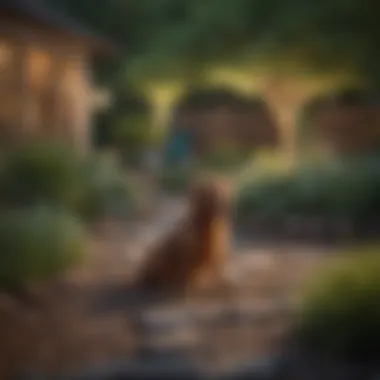
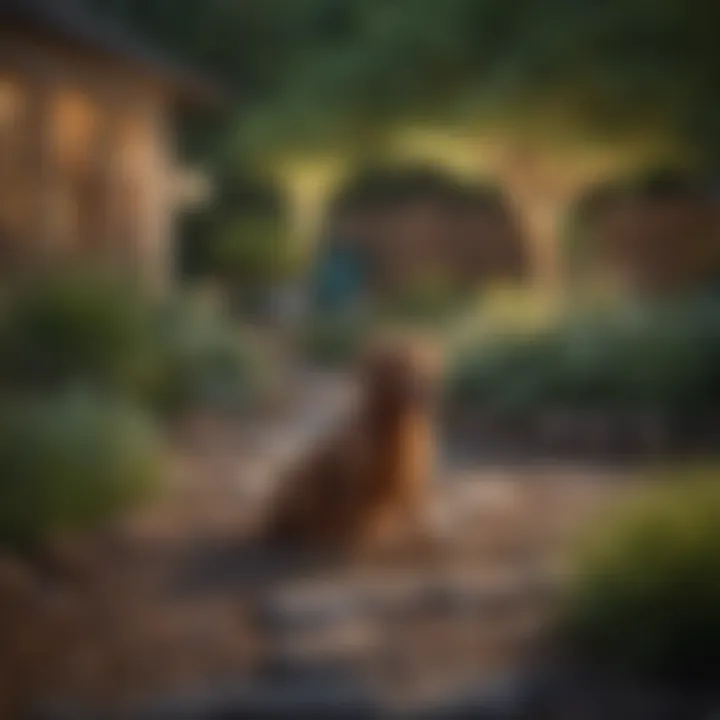
By focusing on these factors, pet owners can ensure that their yard meets their dog's specific behavioral and physical requirements.
The Role of Community and Social Interaction
Creating a dog-friendly environment extends beyond individual yards. It involves fostering a sense of community and establishing connections that enhance the well-being of pets and their owners. Social interaction is essential for dogs, as it helps them develop proper behaviors and reduces anxiety or aggression stemming from isolation. Building a network of fellow dog owners can lead to shared resources, advice, and companionship.
When neighbors engage with one another, they create a supportive network. This exchange can manifest in various ways, from sharing gardening tips on dog-friendly plants to coordinating group walks. The benefits include increased knowledge about local pet regulations, awareness of safe spaces, and organized events that promote dog health and welfare.
“A community that plays together, stays together.” Building connections with other dog owners transforms the yard from a simple space into a social hub.
Creating Playdates in the Park
Playdates in the park provide a structured yet fun environment for dogs to interact. This is vital for socializing puppies or even older dogs who may have experienced limited interaction. Designating specific times for gatherings encourages dog owners to meet at common parks. This allows dogs to form friendships, explore different play styles, and learn appropriate reactions to various breeds.
However, it is important to consider the following:
- Safety Protocols: Prioritize vaccinations and safety checks. Ensure all dogs are healthy and vaccinated to prevent disease spread.
- Space Management: Select parks with ample space, which allows dogs to run freely without feeling confined.
- Organized Activities: Engage in group activities or games that promote socialization, such as fetch or agility courses. These activities can help develop loyalty and confidence in dogs.
Building Dog-Friendly Neighborhoods
Creating neighborhoods that cater to dogs requires collaboration among residents. Designing spaces with canine needs in mind fosters a welcoming atmosphere for both pets and owners. Here are some suggestions for integrating dog-friendly features:
- Dog Parks: Dedicated open spaces for dogs to roam freely and socialize are essential. These parks need secure fencing, varied terrain, and shaded areas.
- Sidewalks and Trails: Make paths wide and accessible to promote safe walking experiences. This encourages dog owners to explore their neighborhoods while allowing dogs the chance to sniff and engage with their environment.
- Community Boards: Establish bulletin boards for resources, lost pet notices, and local events. This keeps residents informed and engaged in their surroundings.
- Pet-Friendly Policies: Advocate for local governments to implement policies that support dog ownership, including waste management and leash laws.
In summary, the role of community in creating a dog-proof yard is crucial. By participating in local activities and engaging with fellow dog owners, one can foster an environment that enhances the overall experience for both pets and their owners. Through shared knowledge, safe playdates, and dedicated spaces, dog owners can cultivate a nurturing and secure habitat that accentuates happiness for all.
Sustainability in Dog-Proof Yard Designs
Sustainability is a crucial aspect of yard design, especially for pet owners. Incorporating sustainable practices not only benefits the environment but also enhances the safety and comfort of dogs. Sustainable designs can reduce waste, conserve resources, and promote a healthy outdoor space. This section will explore how homeowners can achieve sustainability in dog-proof yard designs through the selection of eco-friendly materials and the implementation of sustainable practices.
Choosing Eco-Friendly Materials
The selection of materials plays a vital role in creating a sustainable dog-proof yard. The materials should be non-toxic and durable, ensuring both the health of dogs and longevity of the yard. Here are some eco-friendly materials to consider:
- Recycled plastic fencing: This type of fencing is made from post-consumer waste, allowing a reduction in plastic that would otherwise end up in landfills.
- Bamboo: This rapidly renewable resource can be an excellent choice for fences or landscaping. It is strong, lightweight, and biodegradable.
- Natural stone: Instead of concrete or synthetic materials, using stone sourced sustainably minimizes environmental damage. It provides stability and a natural aesthetic.
- Native plants: Selecting plants that are native to the area reduces water usage and chemical fertilizers, benefiting local wildlife and ecosystem.
These materials not only create a safe environment for dogs but also align with a broader commitment to sustainability in landscaping.
Implementing Sustainable Practices
To engage in sustainable practices is equally important in designing a dog-proof yard. Homeowners can employ the following methods to enhance sustainability:
- Composting: Creating a compost area helps to recycle organic waste and provides nutrient-rich soil for gardens. This can be especially beneficial for plants safe for dogs.
- Rainwater harvesting: Installing rain barrels can conserve water and support irrigation needs. This practice saves water and can lower utility bills.
- Xeriscaping: Opting for a xeriscape design, reduces the need for irrigation. This approach includes drought-resistant plants, which helps save water over time.
- Mulching: Using organic mulch made from wood chips or straw provides insulation for plants, retains moisture, and suppresses weeds.
Implementing these practices fosters an environment that not only accommodates dogs safely but also nurtures the ecosystem.
"Sustainability is not just a trend; it is a necessary approach for future generations. Making your dog-proof yard eco-friendly helps protect the planet while ensuring a safe haven for your pets."
By focusing on sustainable materials and practices, homeowners can create a dog-proof yard that is safe, functional, and resilient against the challenges of both nature and pets.
Common Mistakes in Yard Design for Dogs
Creating a dog-proof yard is a thoughtful process, but it often comes with its pitfalls. Understanding these mistakes can save homeowners from future frustrations and ensure a safe environment for their pets. Various errors can lead to inadequate space, security issues, and unsatisfactory play areas. Recognizing and addressing these common oversights is crucial for any pet owner.
Underestimating Space Requirements
One of the most prevalent mistakes in yard design is underestimating space requirements for dogs. Each breed has its own energy levels and activity needs. Large breeds, like Labrador Retrievers, require more room to run and play, while smaller breeds might need a designated area for exploration.
When designing a dog-friendly yard, consider the following:
- Size of the Dog: Bigger dogs need more space not only to roam but also to engage in physical activities.
- Multiple Pets: If more than one dog resides in your home, ensure that the yard accommodates each pet’s individual space and needs.
- Activity Zones: Designate specific areas for playing, resting, and even training. It's important that these zones do not feel cramped.
Planning sufficient space contributes to the overall happiness and health of dogs, ensuring they have adequate room to exercise and relax appropriately. Forgetting this aspect may lead to behavioral issues, such as anxiety or destructive habits, owing to insufficient outlets for their energy.
Ignoring Dog Behavior and Needs
Another significant oversight is ignoring dog behavior and needs. Not every dog enjoys the same kind of environment. Some dogs thrive in open, grassy areas, while others prefer shaded spots with visual barriers. If the yard does not reflect the dog’s personality, this can lead to discomfort and frustration.
- Understanding Preferences: Note the habits and preferences of your dog. Does it enjoy digging or jumping? These habits should influence the layout of your yard.
- Safety Concerns: Certain behaviors can lead to hazards. For example, a dog that loves to dig may find its way to underground wires or other hazardous materials buried in the yard.
- Environment Engagement: Dogs appreciate sensory experiences. Consider incorporating various textures, scents, and safe objects that engage them.
"Understanding your dog is as vital as creating the space itself. Their behavior can guide how to best utilize the yard."
Ultimately, avoiding these common mistakes in yard design allows pet owners to create an environment that not only safeguards their dogs but also enriches their daily lives. Proper planning can lead to a harmonious relationship between pet and owner, ensuring a delightful shared outdoor space.
Resources for Further Exploration
Exploring available resources on dog care and yard design is essential for any pet owner looking to create a safe and enjoyable environment for their dogs. These resources provide guidance, insights, and community support that can be invaluable when planning or renovating your outdoor space. Understanding the tools at your disposal can significantly enhance the effectiveness of your dog-proof yard, ensuring it meets both the needs of your pets and your aesthetic preferences.
Books and guides often offer comprehensive information, from selecting appropriate landscaping materials to understanding canine behavior. Moreover, online platforms create communities where pet owners share their experiences, tips, and lessons learned. Both types of resources are critical in making informed decisions about how to design a functional yet appealing yard.
"Knowledge is the key to effective planning. Books and community insights can guide you in creating the perfect dog-proof yard."
Books and Guides on Dog Care
Books dedicated to dog care provide a wealth of knowledge that pet owners can reference. These texts often cover a range of topics including dog behavior, training techniques, and safe landscaping practices. Titles like The Complete Dog Manual and Dog Training for Dummies are examples of popular resources that can be beneficial.
- Behavioral Guides: Understanding why dogs behave a certain way can help in yard planning. Books that focus on dog psychology can enlighten owners about how their pets interact with their environment.
- Landscaping Books: Guides that focus on garden design often include sections specifically addressing safe plants for pets, which can prevent accidental poisoning and promote a healthier outdoor area for play.
- Training Resources: These often complement yard design by teaching owners how to establish boundaries and encourage dogs to enjoy their space without straying into hazardous zones.
Choosing books from reputable authors or resources can offer both practical advice and advanced understanding of canine care.
Websites and Online Communities
In today's digital age, websites and online communities serve as a rich resource for pet owners. Platforms like Reddit and Facebook host groups dedicated to dogs and their care. Benefits include:
- Community Discussions: These platforms provide a space for sharing personal experiences, allowing homeowners to learn from each other’s successes and challenges in dog-proof yard design.
- Resource Sharing: Many community members share links to helpful videos, articles, and DIY projects that can inspire creative yard solutions.
- Expert Advice: Some sites feature professionals who offer free advice on dog care and yard design, making it easier to solve specific problems or find new ideas.
Using these online resources provides a continuous stream of updated information that can be tailored to the unique needs of your yard and your pets.















